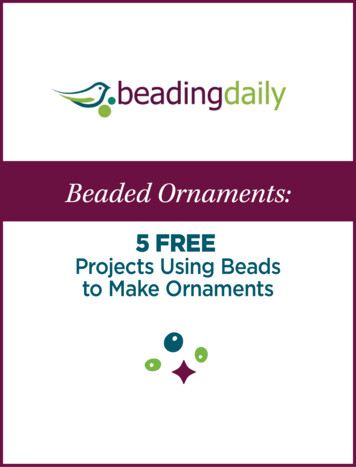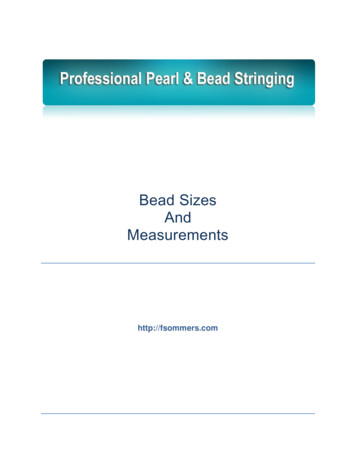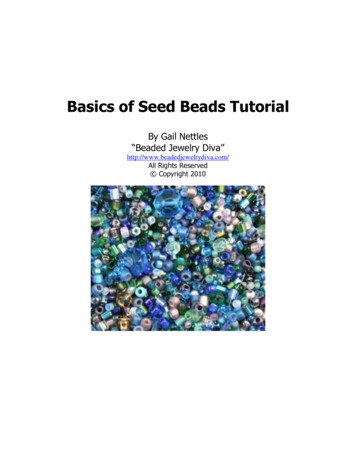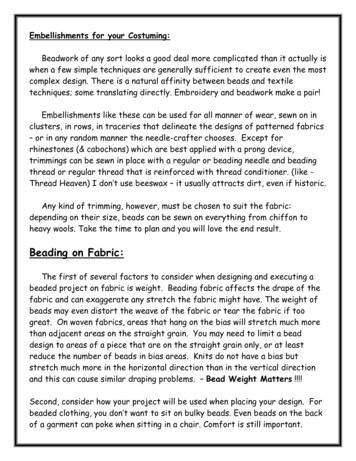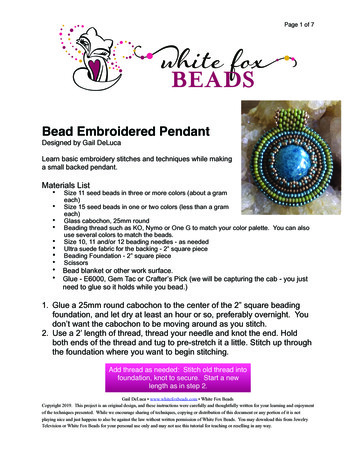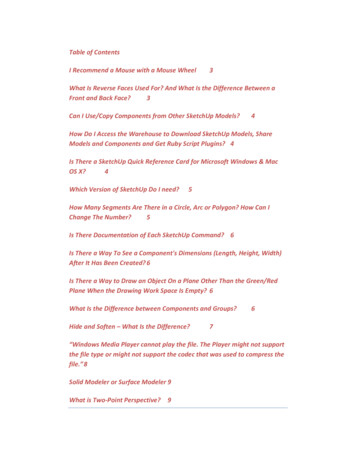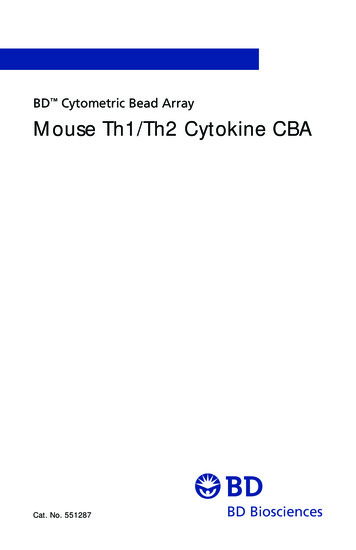
Transcription
BD Cytometric Bead ArrayMouse Th1/Th2 Cytokine CBACat. No. 551287BD Biosciences
For research use only. Not for use in diagnostic or therapeutic procedures. Purchase does not includeor carry any right to resell or transfer this product either as a stand-alone product or as a componentof another product. Any use of this product other than the permitted use without the express writtenauthorization of Becton Dickinson and Company is strictly prohibited.BD, BD Logo and all other trademarks are the property of Becton, Dickinson and Company. 2002 BD
Kit Contents(Store the following items at 4 C)A1 Mouse IL-2 Capture Beads: 1 vial, 0.8 mlA2 Mouse IL-4 Capture Beads: 1 vial, 0.8 mlA3 Mouse IL-5 Capture Beads: 1 vial, 0.8 mlA4 Mouse IFN-γ Capture Beads: 1 vial, 0.8 mlA5 Mouse TNF-α Capture Beads: 1 vial, 0.8 mlBMouse Th1/Th2 PE* Detection Reagent: 1 vial, 4 mlCMouse Th1/Th2 Cytokine Standards: 2 vials, 0.2 ml lyophilizedDCytometer Setup Beads: 1 vial, 1.5 mlE1 PE Positive Control Detector: 1 vial, 0.5 mlE2 FITC Positive Control Detector: 1 vial, 0.5 mlFWash Buffer: 1 bottle, 130 mlGAssay Diluent: 1 bottle, 30 mlPatents: *US 4,520,110, Europe 76,695, Canada, 1,179,942Unless otherwise specified, all products are for Research Use Only.Not for use in diagnostic or therapeutic procedures. Not for resale.www.bdbiosciences.com3
Table of Contents1. Introduction . . . . . . . . . . . . . . . . . . . . . . . . . . . . . . . . . . . . . . . . . . . . . . 52. Principle of the Test . . . . . . . . . . . . . . . . . . . . . . . . . . . . . . . . . . . . . . . . 62.1Advantages . . . . . . . . . . . . . . . . . . . . . . . . . . . . . . . . . . . . . . . . . . 62.2Limitations. . . . . . . . . . . . . . . . . . . . . . . . . . . . . . . . . . . . . . . . . . . 73. Reagents Provided. . . . . . . . . . . . . . . . . . . . . . . . . . . . . . . . . . . . . . . . . . 73.1Bead Reagents . . . . . . . . . . . . . . . . . . . . . . . . . . . . . . . . . . . . . . . . 73.2Antibody and Standard Reagents . . . . . . . . . . . . . . . . . . . . . . . . . . 83.3Buffer Reagents . . . . . . . . . . . . . . . . . . . . . . . . . . . . . . . . . . . . . . . 84. Materials Required but not Provided . . . . . . . . . . . . . . . . . . . . . . . . . . . . 95. Overview: Mouse Th1/Th2 Cytokine CBA Assay Procedure . . . . . . . . . . . 96. Preparation of Mouse Th1/Th2 Cytokine Standards . . . . . . . . . . . . . . . . 107. Preparation of Mixed Mouse Th1/Th2 Cytokine Capture Beads . . . . . . . 118. Preparation of Test Samples. . . . . . . . . . . . . . . . . . . . . . . . . . . . . . . . . . 129. Mouse Th1/Th2 Cytokine CBA Assay Procedure . . . . . . . . . . . . . . . . . . 1210. Cytometer Setup, Data Acquisition and Analysis . . . . . . . . . . . . . . . . . . 1310.1 Preparation of Cytometer Setup Beads. . . . . . . . . . . . . . . . . . . . . . 1310.2 Instrument Setup with BD FACSComp Softwareand BD CaliBRITE Beads . . . . . . . . . . . . . . . . . . . . . . . . . . . . . . 1410.3 Instrument Setup with the Cytometer Setup Beads . . . . . . . . . . . . . 1410.4 Data Acquisition . . . . . . . . . . . . . . . . . . . . . . . . . . . . . . . . . . . . . 1710.5 Analysis of Sample Data . . . . . . . . . . . . . . . . . . . . . . . . . . . . . . . . 1911. Typical Data . . . . . . . . . . . . . . . . . . . . . . . . . . . . . . . . . . . . . . . . . . . . . 1912. Performance . . . . . . . . . . . . . . . . . . . . . . . . . . . . . . . . . . . . . . . . . . . . . 2112.1 Sensitivity. . . . . . . . . . . . . . . . . . . . . . . . . . . . . . . . . . . . . . . . . . . 2112.2 Recovery . . . . . . . . . . . . . . . . . . . . . . . . . . . . . . . . . . . . . . . . . . . 2212.3 Linearity . . . . . . . . . . . . . . . . . . . . . . . . . . . . . . . . . . . . . . . . . . . 2312.4 Specificity. . . . . . . . . . . . . . . . . . . . . . . . . . . . . . . . . . . . . . . . . . . 2412.5 Precision . . . . . . . . . . . . . . . . . . . . . . . . . . . . . . . . . . . . . . . . . . . 2513. Troubleshooting Tips . . . . . . . . . . . . . . . . . . . . . . . . . . . . . . . . . . . . . . 26References . . . . . . . . . . . . . . . . . . . . . . . . . . . . . . . . . . . . . . . . . . . . . . 274www.bdbiosciences.comUnless otherwise specified, all products are for Research Use Only.Not for use in diagnostic or therapeutic procedures. Not for resale.
1. IntroductionFlow cytometry is an analysis tool that allows for the discrimination of differentparticles on the basis of size and color. Multiplexing is the simultaneous assayof many analytes in a single sample. The BD Cytometric Bead Array (CBA)employs a series of particles with discrete fluorescence intensities tosimultaneously detect multiple soluble analytes. The BD CBA is combinedwith flow cytometry to create a powerful multiplexed assay.The BD CBA system uses the sensitivity of amplified fluorescence detectionby flow cytometry to measure soluble analytes in a particle-based immunoassay.Each bead in a CBA provides a capture surface for a specific protein and is analogousto an individually coated well in an ELISA plate. The BD CBA capture bead mixtureis in suspension to allow for the detection of multiple analytes in a small samplevolume. The combined advantages of the broad dynamic range of fluorescentdetection via flow cytometry and the efficient capturing of analytes via suspendedparticles enable the BD CBA to use fewer sample dilutions and to obtain the valueof an unknown in substantially less time (compared to conventional ELISA).The BD Mouse Th1/Th2 Cytokine CBA Kit can be used to measure Interleukin-2(IL-2), Interleukin-4 (IL-4), Interleukin-5 (IL-5), Interferon-γ (IFN-γ), and TumorNecrosis Factor-α (TNF-α) protein levels in a single sample. The kit performancehas been optimized for analysis of physiologically relevant concentrations (pg/mllevels) of specific cytokine proteins in tissue culture supernatants and serumsamples.The BD CBA System, a product of BD Biosciences, was developed jointly byBD Biosciences Immunocytometry Systems and BD Biosciences Pharmingen. Thiskit incorporates the quality, reliability, and service that you have learned to expectfrom BD Biosciences.Unless otherwise specified, all products are for Research Use Only.Not for use in diagnostic or therapeutic procedures. Not for resale.www.bdbiosciences.com5
2. Principle of the TestFive bead populations with distinct fluorescence intensities have been coatedwith capture antibodies specific for IL-2, IL-4, IL-5, IFN-γ, and TNF-α proteins.The five bead populations are mixed together to form the CBA, which is resolvedin the FL3 channel of a flow cytometer such as the BD FACScan orBD FACSCalibur flow cytometer.IL-4IFN-γIL-2IL-5TNF-αFigure 1The cytokine capture beads are mixed with the PE-conjugated detectionantibodies and then incubated with recombinant standards or test samples toform sandwich complexes. Following acquisition of sample data using the flowcytometer, the sample results are generated in graphical and tabular format usingthe BD CBA Analysis Software. The kit provides sufficient reagents for the quantitativeanalysis of 50 test samples and the generation of two standard curve sets.2.1AdvantagesThe CBA provides several advantages when compared with conventional ELISAmethodology:6 The required sample volume is approximately one-fifth the quantitynecessary for conventional ELISA assays due to the detection of fiveanalytes in a single sample. A single set of diluted standards is used to generate a standard curve foreach analyte. A CBA experiment takes less time than a single ELISA and provides resultsthat would normally require five conventional ELISAswww.bdbiosciences.comUnless otherwise specified, all products are for Research Use Only.Not for use in diagnostic or therapeutic procedures. Not for resale.
2.2LimitationsThe sensitivity of the Mouse Th1/Th2 Cytokine CBA is comparable toconventional ELISA, but due to the complexity and kinetics of this multi-analyteassay, actual sensitivity on a given experiment may vary slightly (See sensitivityand precision information in Section 12.1 and 12.5).The BD CBA is not recommended for use on stream-in-air instrumentswhere signal intensities may be reduced, adversely effecting assay sensitivity.Stream-in-air instruments include the BD FACStar Plus and BD FACSVantage (BD Immuncytometry Systems, San Jose, CA) flow cytometers.Serum spike recoveries for IL-4 and TNF-α are lower than for the other cytokinesin this assay. This variation is due to assay conditions and serum proteins andmay affect quantitation of these proteins in serum samples.3. Reagents Provided3.1Bead ReagentsMouse Cytokine Capture Beads (A1 – A5): The specific capture beads, havingdiscrete fluorescence intensity characteristics, are distributed from brightest todimmest as follows:BeadSpecificity(Brightest) A1IL-2A2IL-4A3IL-5A4IFN-γ(Dimmest) A5TNF-αA single 70-test vial of each specific capture bead (A1 – A5) is included in this kit.Store at 4 C. Do not freeze.Note:The antibody-conjugated beads will settle out of suspensionover time. It is necessary to vortex the vial vigorously for 3 - 5seconds before taking a bead suspension aliquot.Cytometer Setup Beads (D): A single 30-test vial of setup beads for settingthe initial instrument PMT voltages and compensation settings is sufficient for10 instrument setup procedures. The Cytometer Setup Beads are formulatedfor use at 50 µl/test.Unless otherwise specified, all products are for Research Use Only.Not for use in diagnostic or therapeutic procedures. Not for resale.www.bdbiosciences.com7
3.2Antibody and Standard ReagentsMouse Th1/Th2 PE Detection Reagent (B): A 70-test vial of PE-conjugatedanti-mouse IL-2, IL-4, IL-5, IFN-γ, and TNF-α antibodies that is formulatedfor use at 50 µl/test. Store at 4 C. Do not freeze.PE Positive Control Detector (E1): A 10-test vial of PE-conjugated antibodycontrol that is formulated for use at 50 µl/test. This reagent is used with theCytometer Setup Beads to set the initial instrument compensation settings.Store at 4 C. Do not freeze.FITC Positive Control Detector (E2): A 10-test vial of FITC-conjugated antibodycontrol that is formulated for use at 50 µl/test. This reagent is used with theCytometer Setup Beads to set the initial instrument compensation settings.Store at 4 C. Do not freeze.Mouse Th1/Th2 Cytokine Standards (C): Two vials containing lyophilizedrecombinant mouse cytokine proteins. Each vial should be reconstituted in0.2 ml of Assay Diluent to prepare a 10 bulk standard. The reconstituted10 bulk standard contains 50 ng/ml of each recombinant mouse IL-2, IL-4,IL-5, IFN-γ and TNF-α protein. Store at 4 C.Note:3.3The Mouse Th1/Th2 Cytokine Standards vials are stable untilthe kit expiration date. Following reconstitution, store the freshlyreconstituted 10 bulk standard at 2 – 8 C and use within 12 hours.Buffer ReagentsAssay Diluent (G): A single 30 ml bottle of a buffered protein* solution (1 ) usedto reconstitute and dilute the Mouse Th1/Th2 Cytokine Standards and to dilutetest samples. Store at 4 C.Wash Buffer (F): A single 130 ml bottle of phosphate buffered saline (PBS)solution (1 ), containing protein* and detergent, used for wash steps and toresuspend the washed beads for analysis. Store at 4 C.Hazardous Ingredients:Sodium Azide:Components A1 - A5 and D contain 0.1% sodium azide.Components B, E1 - E2, G and F contain 0.09% sodium azide.Sodium azide yields a highly toxic hydrazoic acid under acidicconditions. Avoid exposure to skin and eyes, ingestion, andcontact with heat, acids, and metals. Wash exposed skin withsoap and water. Flush eyes with water. Dilute azide compoundsin running water before discarding to avoid accumulation ofpotentially explosive deposits in plumbing.*Source of all serum proteins is from the United States8www.bdbiosciences.comUnless otherwise specified, all products are for Research Use Only.Not for use in diagnostic or therapeutic procedures. Not for resale.
4. Materials Required but not ProvidedIn addition to the reagents provided in the Mouse Th1/Th2 Cytokine CBA Kit,the following items are also required: A flow cytometer equipped with a 488 nm laser capable of detecting anddistinguishing fluorescence emissions at 576 and 670 nm (eg, BD FACScanor BD FACSCalibur instruments) and BD CellQuest Software. 12 75 mm sample acquisition tubes for a flow cytometer(eg, BD Falcon Cat. No. 352008.) BD CBA Software, (Cat. No. 550065).Note: For use with BD CellQuest Software. Microsoft Excel anda Macintosh or PC-compatible computer are required to utilizethe BD CBA Software. See the BD CBA Software User’s Guidefor details.BD CaliBRITE 3 Beads, (Cat. No. 340486).5. Overview: Mouse Th1/Th2 CytokineCBA Assay Procedure1. Reconstitute Mouse Th1/Th2 Cytokine Standards (15 min)in Assay Diluent2. Dilute Standards by serial dilutions using the Assay Diluent3. Mix 10 µl/test of each Mouse Cytokine CaptureBead suspension (vortex before aliquoting)4. Transfer 50 µl of mixed beads to each assay tube5. Add Standard Dilutions and test samples to theappropriate sample tubes (50 µl/tube)6. Add PE Detection Reagent (50 µl/test)2 hour incubation at RT(protect from light)*7. Wash samples with 1 ml Wash Buffer and centrifuge8. Add 300 µl of Wash Buffer to each assay tubeand analyze samples*Cytometer Setup Bead Procedure1. Add Cytometer Setup Beads(vortex before adding) to setuptubes A, B and C (50 µl/tube)2. Add 50 µl of FITC PositiveControl to tube B and 50 µl ofPE Positive Control to tube C30 minuteincubation at RT(protect from light)Unless otherwise specified, all products are for Research Use Only.Not for use in diagnostic or therapeutic procedures. Not for resale.3. Add 400 µl of Wash Buffer totubes B and C4. Add 450 µl of Wash Buffer totube A5. Use tubes A, B and C forcytometer setupwww.bdbiosciences.com9
6. Preparation of Mouse Th1/Th2Cytokine StandardsThe Mouse Th1/Th2 Cytokine Standards are lyophilized and should bereconstituted and serially diluted before mixing with the Capture Beadsand the PE Detection Reagent.1. Reconstitute 1 vial of lyophilized Mouse Th1/Th2 Cytokine Standardswith 0.2 ml of Assay Diluent to prepare a 10 bulk standard. Allow thereconstituted standard to equilibrate for at least 15 minutes before makingdilutions. Agitate vial to mix thoroughly.2. Label 12 75 mm tubes (BD Falcon, Cat. No. 352008) and arrange themin the following order: Top Standard, 1:2, 1:4, 1:8, 1:16, 1:32, 1:64, 1:128and 1:256.3. Add 900 µl of Assay Diluent to the Top Standard tube.4. Add 300 µl of Assay Diluent to each of the remaining tubes.5. Transfer 100 µl of 10 bulk standard to the Top Standard tube and mixthoroughly.6. Perform a serial dilution by transferring 300 µl from the Top Standard tothe 1:2 dilution tube and mix thoroughly. Continue making serial dilutionsby transferring 300 µl from the 1:2 tube to the 1:4 tube and so on to the1:256 tube and mix thoroughly (see Figure 2.) The Assay Diluent serves asthe negative control.100 µl10 StockStandard300 µlTopStandard300 µl1:2DilutionTube1:4DilutionTube300 µl300 µl1:8DilutionTube1:16DilutionTube300 µl300 µl1:32DilutionTube300 µl1:64DilutionTube300 µl1:128DilutionTube1:256DilutionTubeFigure 2. Preparation of Mouse Th1/Th2 Cytokine Standard DilutionsThe approximate concentration (pg/ml) of recombinant protein in each dilutiontube is shown in Table 1.10www.bdbiosciences.comUnless otherwise specified, all products are for Research Use Only.Not for use in diagnostic or therapeutic procedures. Not for resale.
Table 1. Mouse Th1/Th2 Cytokine Standard concentrations after lutionTubeMouse IL-2500025001250625312.5156804020Mouse IL-4500025001250625312.5156804020Mouse IL-5500025001250625312.5156804020Mouse IFN-γ500025001250625312.5156804020Mouse TNF-α500025001250625312.51568040207. Preparation of Mixed Mouse Th1/Th2Cytokine Capture BeadsThe Capture Beads are bottled individually and it is necessary to pool the beadreagents (A1 – A5) immediately before mixing them together with the standards,samples and PE Detection reagent.1. Determine the number of assay tubes (including standards and controls)that are required for the experiment (eg, 8 unknowns, 9 cytokine standarddilutions and 1 negative control 18 assay tubes.)2. Vigorously vortex each Capture Bead suspension for a few secondsbefore mixing.3. Add a 10 µl aliquot of each Capture Bead, for each assay tubeto be analyzed, into a single tube labeled “mixed Capture beads”(eg, 10 µl of IL-2 Capture Beads 18 assay tubes 180 µl of IL-2Capture Beads required).Note:Extra tests of Capture beads should be mixed to ensure thatthe necessary number of tests will be recovered from the mixedCapture beads tube. (eg, add an additional 2 – 3 assay tubesto the number determined in step 1 above before calculatingthe amount to add to the mixed capture beads tube in step 3).4. Vortex the Bead mixture thoroughly.The mixed Capture beads are now ready to be transferred to the assay tubes(50 µl of mixed Capture beads/tube) as described in Section 9.Note:Discard excess mixed Capture Beads. Do not store after mixing.Unless otherwise specified, all products are for Research Use Only.Not for use in diagnostic or therapeutic procedures. Not for resale.www.bdbiosciences.com11
8. Preparation of Test SamplesThe standard curve for each cytokine covers a defined set of concentrations from20 – 5000 pg/ml. It may be necessary to dilute test samples to ensure that theirmean fluorescence values fall within the limits or range of the generated cytokinestandard curve. For best results, samples that are known or assumed to containhigh levels of a given cytokine should be diluted as described below.1. Dilute test sample by the desired dilution factor (ie, 1:2, 1:10 or 1:100)using the appropriate volume of Assay Diluent.2. Mix sample dilutions thoroughly before transferring samplesto the appropriate assay tubes containing mixed Capture beadsand PE Detection Reagent.9. Mouse Th1/Th2 Cytokine CBA Assay ProcedureFollowing the preparation and dilution of the standards and mixing ofthe capture beads, transfer these reagents and test samples to the appropriateassay tubes for incubation and analysis. In order to calibrate the flow cytometerand quantitate test samples, it is necessary to run the Cytokine Standards andthe Cytometer Setup controls in each experiment. See Table 2 for a detaileddescription of the reagents added to the Cytokine Standard control assaytubes. The Cytometer Setup procedure is described in Section 10.1. Add 50 µl of the mixed Capture beads to the appropriate assay tubes.Vortex the mixed Capture beads before adding to the assay tubes.2. Add 50 µl of the Mouse Th1/Th2 Cytokine Standard dilutions to thecontrol assay tubes.3. Add 50 µl of each test sample to the test assay tubes.4. Add 50 µl of the Mouse Th1/Th2 PE Detection Reagent to the assay tubes.5. Incubate the assay tubes for 2 hours at RT and protect from directexposure to light.6. Add 1 ml of Wash Buffer to each assay tube and centrifuge at 200 gfor 5 minutes.7. Carefully aspirate and discard the supernatant from each assay tube.8. Add 300 µl of Wash Buffer to each assay tube to resuspend the bead pellet.9. Begin analyzing samples on a flow cytometer. Vortex each sample for3 - 5 seconds immediately before analyzing on the flow cytometer.Note:12It is necessary to analyze CBA samples on the day of theexperiment. Prolonged storage of samples, once the assayis complete, can lead to increased background and reducedsensitivity.www.bdbiosciences.comUnless otherwise specified, all products are for Research Use Only.Not for use in diagnostic or therapeutic procedures. Not for resale.
Table 2. Essential control assay tubesReagents(All reagents volumes are 50 µl)Tube No.1 (Negative Control0 pg/ml Standards)mixed Capture beads, Assay Diluent, PE Detection Reagent2 (20 pg/ml Standards)mixed Capture beads, Cytokine Standards 1:256 Dilution, PE Detection Reagent3 (40 pg/ml Standards)mixed Capture beads, Cytokine Standards 1:128 Dilution, PE Detection Reagent4 (80 pg/ml Standards)mixed Capture beads, Cytokine Standards 1:64 Dilution, PE Detection Reagent5 (156 pg/ml Standards)mixed Capture beads, Cytokine Standards 1:32 Dilution, PE Detection Reagent6 (312 pg/ml Standards)mixed Capture beads, Cytokine Standards 1:16 Dilution, PE Detection Reagent7 (625 pg/ml Standards)mixed Capture beads, Cytokine Standards 1:8 Dilution, PE Detection Reagent8 (1250 pg/ml Standards)mixed Capture beads, Cytokine Standards 1:4 Dilution, PE Detection Reagent9 (2500 pg/ml Standards)mixed Capture beads, Cytokine Standards 1:2 Dilution, PE Detection Reagent10 (5000 pg/ml Standards)mixed Capture beads, Cytokine Standards "Top Standard", PE Detection Reagent10. Cytometer Setup, Data Acquisition and AnalysisThe Cytometer setup information in this section is for the BD FACScan andBD FACSCalibur flow cytometers. The BD FACSComp software is useful forsetting up the flow cytometer. BD CellQuest Software is required for analyzingsamples and formatting data for subsequent analysis using the BD CBA Software.10.1 Preparation of Cytometer Setup Beads1. Add 50 µl of Cytometer Setup Beads to three cytometer setup tubes labeledA, B and C.2. Add 50 µl of FITC Positive Control Detector to tube B.3. Add 50 µl of PE Positive Control Detector to tube C.4. Incubate tubes A, B and C for 30 minutes at room temperature and protectfrom direct exposure to light.5. Add 450 µl of Wash Buffer to tube A and 400 µl of Wash Buffer to tubesB and C.6. Proceed to Section 10.2.Unless otherwise specified, all products are for Research Use Only.Not for use in diagnostic or therapeutic procedures. Not for resale.www.bdbiosciences.com13
10.2 Instrument Setup with BD FACSComp Softwareand BD CaliBRITE Beads1. Perform instrument start up.2. Perform flow check.3. Prepare tubes of BD CaliBRITE beads and open BD FACSComp software.4. Launch BD FACSComp software5. Run BD FACSComp software in Lyse/No Wash mode.6. Proceed to section 10.3.Note:For detailed information on using BD FACSComp withBD CaliBRITE beads to set up the flow cytometer, refer to theBD FACSComp Software User’s Guide and the BD CaliBRITEBeads Package Insert. Version 4.2 contains a BD CBA preferencesetting to automatically save a BD CBA calibration file at thesuccessful completion of any Lyse/No Wash assay. The BD CBAcalibration file provides the optimization for FSC, SSC, andthreshold settings as described in Section 10.3, Steps 3 – 5.Optimization of the fluorescence parameter settings is stillrequired (ie, PMT and compensation settings, see Section10.3, Step 6).10.3 Instrument Setup with the Cytometer Setup Beads1. Launch BD CellQuest Software and open the CBA Instrument Setup template.Note:The BD CBA Instrument Setup template can be found on theBD CBA software or BD FACStation CD for Macintosh computers inthe BD CBA folder. Following installation on Macintosh computersusing BD CBA Software Version 1.0, the template can be found inthe BD Applications/BD CBA folder/Sample Files/Mouse IsotypingFiles/Instrument Setup folder. For BD CBA Software Version 1.1 orhigher, the template can be found in the BD Applications/BD CBAfolder. The template is not installed from the CD on PC-compatiblecomputers. This file may also be downloaded via the internet wnloads.shtml2. Set the instrument to Acquisition mode.Note:The BD CBA Software will evaluate data in five parameters(FSC, SSC, FL1, FL2 and FL3). Turn off additional detectors.3. Set SSC (side light scatter) and FSC (forward light scatter) to Log mode.4. Decrease the SSC PMT voltage by 100 from what FACSComp set.5. Set the Threshold to FSC at 650.6. In setup mode, run Cytometer Setup Beads tube A. Follow the setupinstructions on pages 14 - 16.Note:14Pause and restart acquisition frequently during the instrumentsetup procedure in order to reset detected values after settingsadjustments.www.bdbiosciences.comUnless otherwise specified, all products are for Research Use Only.Not for use in diagnostic or therapeutic procedures. Not for resale.
104Adjust gate R1 so that the singlet bead population is located in gate R1 (Figure 3a).100101102SSC-H103R1100101102103104FSC-HFigure 3a104Adjust the FL3 PMT so that the median of the top FL3 bead population’s intensityis around 5000 (Figure 3b). Adjust gate R3 as necessary so that the dim FL3 beadpopulation is located in gate R3 (Figure 3b). Do not adjust the R2 ht Beads (R2)Median: 5139.70FL1 (Median)Median: 2.53Figure 3bAdjust the FL1 PMT so that the median of FL1 is approximately 2.0 – 2.5 (Figure 3b).102100101FL3-H103104Adjust the FL2 PMT value so that the median of FL2 is approximately 2.0 - 2.5(Figure 3c).100101103102104FL2-HFL2 (Median)Median: 2.21Figure 3cRun Cytometer Setup Beads tube B to adjust the compensation settings forFL2 – %FL1.Unless otherwise specified, all products are for Research Use Only.Not for use in diagnostic or therapeutic procedures. Not for resale.www.bdbiosciences.com15
102R5R4100101FL2-H103104Adjust gate R5 as necessary so that the FL1 bright bead population is located ingate R5 (Figure 3d). Using the FL2 – %FL1 control, adjust the median of R5 toequal the median of R4 (Figure 3d).101100103102104FL1-H(R4) Median: 2.94(R5) Median: 3.75Figure 3dRun Cytometer Setup Beads tube C to adjust the compensation settings forFL1 – %FL2 and FL3 – %FL2.R7102FL1-H103104Adjust gate R7 so that the FL2 bright bead population is located in gate R7(Figure 3e). Using the FL1 – %FL2 control, adjust the median of R7 to equalthe median of R6 (Figure 3e).100101R6100101103102104FL2-H(R6) Median: 2.81(R7) Median: 3.08Figure 3e102R9R8100101FL3-H103104Adjust gate R9 so that the FL2 bright bead population is located in gate R9(Figure 3f). Using the FL3 – %FL2 control, adjust the median of R9 to equalthe median of R8 (Figure 3f).100101102103104FL2-H(R8) Median: 27.88(R9) Median: 28.13Figure 3fSet the FL2 – %FL3 to 0.1 if necessary. Save and print the optimized instrument settings.16www.bdbiosciences.comUnless otherwise specified, all products are for Research Use Only.Not for use in diagnostic or therapeutic procedures. Not for resale.
10.4 Data Acquisition1. Open the acquisition template on the BD CBA Software.Note:Following installation of the BD CBA Software, the Acquisitiontemplate is located in the BD Applications/BD CBA Folder/SampleFiles/Mouse Isotyping Files/Instrument Set Up Folder and islabeled “Isotype Kit Acquire Template”. Alternatively, theAcquisition template may be downloaded via the internetfrom: http://www.pharmingen.com/newprod/cba files.shtml2. Set acquisition mode and retrieve the optimized instrument settings fromSection 10.3.3. In the Acquisition and Storage window, set the resolution to 1024.4. Set number of events to be counted at 1500 of R1 gated events. (This willensure that the sample file contains approximately 300 events per Capture Bead).5. Set number of events to be collected to “all events”. Saving allevents collected will ensure that no true bead events are lost dueto incorrect gating.6. In setup mode, run tube no. 1 and using the FSC vs. SSC dot plot, placethe R1 region gate around the singlet bead population (See Figure 3a).7. Samples are now ready to be acquired.8. Begin sample acquisition with the flow rate set at HIGH.Note:Run the negative control tube (0 pg/ml standards) before anyof the recombinant standard tubes. Run the control assay tubesbefore any unknown test assay tubes. Run the tubes in the orderlisted in Table 2 of Section 9.To facilitate analysis of data files using the BD CBA Softwareand to avoid confusion, add a numeric suffix to each file thatcorresponds to the assay tube number (ie, Tube No. 1 containing0 pg/ml could be saved as KT032598.001). The file name mustbe alphanumeric (ie, contain at least one letter).Unless otherwise specified, all products are for Research Use Only.Not for use in diagnostic or therapeutic procedures. Not for resale.www.bdbiosciences.com17
Figure 4. Acquisition Template Example18www.bdbiosciences.comUnless otherwise specified, all products are for Research Use Only.Not for use in diagnostic or therapeutic procedures. Not for resale.
10.5 Analysis of Sample DataThe analysis of BD CBA data is optimized when using the BD CBA Software.Install the software according to the instructions in the Software User’s Guide.1. Transfer the FACS file data for the experiment to the computer with theBD CBA Software.2. Create two new file folders and label one “Standards” and the other “Samples”.3. Move data files to the appropriate folders.Note:Only the files for control assay tubes no. 1 – 10 (the PEDetection Reagent alone and the dilution of standards) should bemoved to the “Standards” file folder. All other samples should bemoved to the “Samples” file folder.Follow the instructions for analysis given in the BD CBA Software User’s Guide.Note:When entering analyte concentrations for the standards used inthe experiment, it is necessary to give names to each analyte. Forthe Mouse Th1/Th2 Cytokine CBA, analyte 1 is TNF-α, analyte2 is IFN-γ, analyte 3 is IL-5, analyte 4 is IL-4, analyte 5 is IL-2.11. Typical DataStandards 80 pg/mlNegative Control4A. 1031010210110100103FL3-HFL3-H104B. 1010100101102103102104100101Standards 625 pg/ml10101021011001010010110231043FL3-H10104D. 103FL3-H102Standards 5000 pg/ml4C. gure 5. BD CellQuest Data Examples for Standards and Detectors AloneUnless otherwise specified, all products are for Research Use Only.Not for use in diagnostic or therapeutic procedures. Not for resale.www.bdbiosciences.com19
00010000110Concentration (pg/ml)100100010000100010000Co
BD FACSCalibur flow cytometer. Figure 1 The cytokine capture beads are mixed with the PE-conjugated detection antibodies and then incubated with recombinant standards or test samples to form sandwich complexes. Following acquisition of sample data using the flow cytometer, the sample results are generated in graphical and tabular format using
